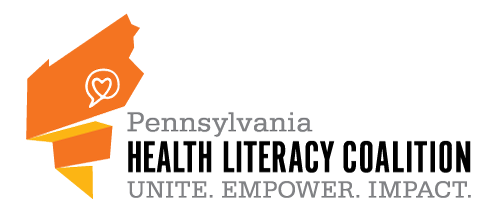October is Health Literacy Month! It is the perfect time to reflect on the role that health communication plays in promoting healthy behaviors. Not communicating well can lead to high use of crisis care, lesser use of preventive care, and overall poorer health. Whether patient or provider, we all have a role to play in communicating clearly.
If you have trouble understanding health information, you are not alone. Up to 90% of people in Pennsylvania find it difficult at times. As a patient, you can:
- Ask questions. Ask Me 3 is one tool that can help you. If you don’t understanding something, speak up!
- Think about how you learn best. Do you like to read? Would you rather watch a video? Does it help to write it down? Ask if you can receive information in a way that works for you.
- Involve a support person in your care. You may not be allowed to bring a friend or family member to an in-person appointment because of COVID-19. There are other ways to involve them in your care. You can call them during or after your appointment. They can sit with you during a video visit. Ask your doctor what you are allowed to do to get the support you need.
- Repeat back what you need to do. You can say, “I want to make sure I understand my care. After this appointment, I need to…” Your provider will be able to clear up confusion.
The health care system is complex and hard to navigate. Organizations must do their part to make health communication easier. Healthy People 2030 gives a new definition of health literacy. It emphasizes the responsibility of organizations and systems in meeting the health literacy needs of the people they serve. Healthy People 2030 also emphasizes the link between health literacy and health equity. One of its overarching goals is to eliminate health disparities, achieve health equity, and attain health literacy to improve the health and well-being of all. Health literacy has a greater impact on historically marginalized communities, and meeting health literacy needs is important in decreasing health disparities and promoting health equity.
Pennsylvania Health Literacy Coalition (PAHLC) is a statewide coalition funded by the Preventive Health and Health Services Block Grant through the Department of Health and led by the Health Care Improvement Foundation. Provider training, organizational change, cross-sector partnerships, and patient empowerment are cornerstones of PAHLC’s work. The ultimate goal of these activities is to improve health communication and ensure good health. Building upon this foundation, PAHLC is taking action to ensure that our work is diverse, inclusive, and aligned with the principles of health literacy and anti-racism. In the next three years, we will be updating training materials, establishing a new leadership committee of health literacy champions, engaging experts in health equity to build capacity for systemic change, and evaluating programs for additional opportunities to address disparities.
This Health Literacy Month, the Pennsylvania Health Literacy Coalition challenges you to move past awareness and into action by taking one or more of the following steps:
- Use plain language. Break down complex topics, and explain things in a way that a family member or friend who is not a health professional would understand.
- When having conversations about health, confirm understanding using a best practice like teach-back. If you are new to teach-back, try it with one patient or client per day. If you are experienced in the use of teach-back, ask colleagues how they confirm understanding and share your secrets for success.
- Visit the Health Literacy Month website for resources, toolkits, and more ideas to get involved.
